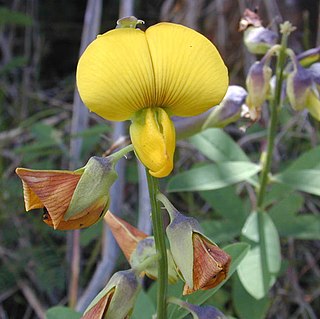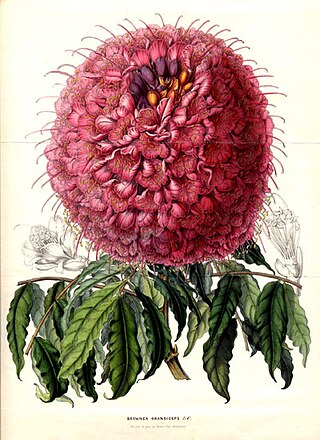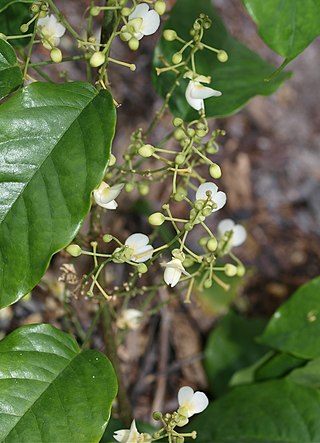
The Mimosoideae are a traditional subfamily of trees, herbs, lianas, and shrubs in the pea family (Fabaceae) that mostly grow in tropical and subtropical climates. They are typically characterized by having radially symmetric flowers, with petals that are twice divided (valvate) in bud and with numerous showy, prominent stamens.

The Fabaceae or Leguminosae, commonly known as the legume, pea, or bean family, are a large and agriculturally important family of flowering plants. It includes trees, shrubs, and perennial or annual herbaceous plants, which are easily recognized by their fruit (legume) and their compound, stipulate leaves. The family is widely distributed, and is the third-largest land plant family in number of species, behind only the Orchidaceae and Asteraceae, with about 765 genera and nearly 20,000 known species.

The Faboideae are a subfamily of the flowering plant family Fabaceae or Leguminosae. An acceptable alternative name for the subfamily is Papilionoideae, or Papilionaceae when this group of plants is treated as a family.

Rhizobia are diazotrophic bacteria that fix nitrogen after becoming established inside the root nodules of legumes (Fabaceae). To express genes for nitrogen fixation, rhizobia require a plant host; they cannot independently fix nitrogen. In general, they are gram negative, motile, non-sporulating rods.

A legume is a plant in the family Fabaceae, or the fruit or seed of such a plant. When used as a dry grain, the seed is also called a pulse. Legumes are grown agriculturally, primarily for human consumption, for livestock forage and silage, and as soil-enhancing green manure. Well-known legumes include beans, soybeans, chickpeas, peanuts, lentils, lupins, grass peas, mesquite, carob, tamarind, alfalfa, and clover. Legumes produce a botanically unique type of fruit – a simple dry fruit that develops from a simple carpel and usually dehisces on two sides.

Styphnolobium is a small genus of three or four species of small trees and shrubs in the subfamily Faboideae of the pea family Fabaceae, formerly included within a broader interpretation of the genus Sophora. It was recently assigned to the unranked, monophyletic Cladrastis clade. They differ from the genus Calia (mescalbeans) in having deciduous leaves and flowers in axillary, not terminal, racemes. The leaves are pinnate, with 9–21 leaflets, and the flowers in pendulous racemes similar to those of the black locust. Necklacepod is a common name for plants in this genus.

Melilotus, known as melilot, sweet clover, and kumoniga, is a genus in the family Fabaceae. Members are known as common grassland plants and as weeds of cultivated ground. Originally from Europe and Asia, it is now found worldwide.

Acacia, commonly known as the wattles or acacias, is a large genus of shrubs and trees in the subfamily Mimosoideae of the pea family Fabaceae. Initially, it comprised a group of plant species native to Africa and Australasia. The genus name is Neo-Latin, borrowed from the Greek ἀκακία, a term used by Dioscorides for a preparation extracted from the leaves and fruit pods of Vachellia nilotica, the original type of the genus. In his Pinax (1623), Gaspard Bauhin mentioned the Greek ἀκακία from Dioscorides as the origin of the Latin name.

The subfamily Detarioideae is one of the subdivisions of the plant family Fabaceae (legumes). This subfamily includes many tropical trees, some of which are used for timber or have ecological importance. The subfamily consists of 84 genera, most of which are native to Africa and Asia. Pride of Burma and tamarind are two of the most notable species in Detarioideae. It has the following clade-based definition:
The most inclusive crown clade containing Goniorrhachis marginataTaub. and Aphanocalyx cynometroidesOliv., but not Cercis canadensisL., Duparquetia orchidaceaBaill., or Bobgunnia fistuloides(Harms) J. H. Kirkbr. & Wiersema.

The Datiscaceae are a family of dicotyledonous plants, containing two species of the genus Datisca. Two other genera, Octomeles and Tetrameles, are now classified in the family Tetramelaceae.

Chapmannia is a genus of flowering plants in the family Fabaceae. It contains seven species with a scattered distribution – Mexico, Guatemala, Florida, and Venezuela in the Americas, and Somalia and Socotra in eastern Africa. The genus was recently assigned to the informal monophyletic Pterocarpus clade of the Dalbergieae.

Aeschynomene is a genus of flowering plants in the family Fabaceae, and was recently assigned to the informal monophyletic Dalbergia clade of the Dalbergieae. They are known commonly as jointvetches. They range across tropical and subtropical regions of the Americas, sub-Saharan Africa, south, southeast, and east Asia, and Australia. These legumes are most common in warm regions and many species are aquatic.

Psorothamnus is a genus of plants in the legume family. These are shrubs and small trees. Many are known by the general common name indigo bush. Some are referred to as daleas, as this genus was once included in genus Dalea. These are generally thorny, thickly branched, strongly scented bushes. Most species bear lupinlike raceme inflorescences of bright purple legume flowers and gland-rich pods. Psorothamnus species are native to the southwestern United States and northern Mexico. The genus is paraphyletic and it has been proposed that the genus Psorodendron be reinstated to accommodate sections Xylodalea, Capnodendron, and Winnemucca.

Cercidoideae is a subfamily in the pea family, Fabaceae. Well-known members include Cercis (redbuds), including species widely cultivated as ornamental trees in the United States and Europe, Bauhinia, widely cultivated as an ornamental tree in tropical Asia, and Tylosema, a semi-woody genus of Africa. The subfamily occupies a basal position within the Fabaceae and is supported as monophyletic in many molecular phylogenies. At the 6th International Legume Conference, the Legume Phylogeny Working Group proposed elevating the tribe Cercidae to the level of subfamily within the Leguminosae (Fabaceae). The consensus agreed to the change, which was fully implemented in 2017. It has the following clade-based definition:
The most inclusive crown clade containing Cercis canadensisL. and Bauhinia divaricataL. but not Poeppigia proceraC.Presl, Duparquetia orchidaceaBaill., or Bobgunnia fistuloides(Harms) J.H.Kirkbr. & Wiersema.

Airyantha is a small genus of flowering plants in the legume family, Fabaceae. It belongs to the subfamily Faboideae. It was named after the botanist Herbert Kenneth Airy Shaw. It was traditionally assigned to the tribe Sophoreae; however, recent molecular phylogenetic analyses reassigned Airyantha into the Baphieae tribe.

Hypocalyptus is a genus of flowering plants in the legume family, Fabaceae. It includes three species of shrubs, subshrubs or small trees native to the Cape region of South Africa. Typical habitats include Mediterranean-climate shrubland (fynbos) at forest margins, in rocky and sandy areas, and along streams, often at high elevations.

The tribe Dalbergieae is an early-branching clade within the flowering plant subfamily Faboideae. Within that subfamily, it belongs to an unranked clade called the dalbergioids. It was recently revised to include many genera formerly placed in tribes Adesmieae and Aeschynomeneae and to be included in a monophyletic group informally known as the dalbergioids sensu lato. The members of this tribe have a distinctive root nodule morphology, often referred to as an "aeschynomenoid" or "dalbergioid" nodule.

The Genistoids are one of the major radiations in the plant family Fabaceae. Members of this phylogenetic clade are primarily found in the Southern hemisphere. Some genera are pollinated by birds. The genistoid clade is consistently resolved as monophyletic in molecular phylogenetic analyses. It is estimated to have arisen 56.4 ± 0.2 million years ago. A node-based definition for the genistoids is: "the MRCA of Poecilanthe parviflora and Lupinus argenteus." One morphological synapomorphy has been tentatively identified: production of quinolizidine alkaloids. Some genera also accumulate pyrrolizidine. A new genus, to be segregated from Clathrotropis, has also been proposed to occupy an undetermined position within the genistoid clade.

Genisteae is a tribe of trees, shrubs and herbaceous plants in the subfamily Faboideae of the family Fabaceae. It includes a number of well-known plants including broom, lupine (lupin), gorse and laburnum.
Meso-Papilionoideae is a monophyletic clade of the flowering plant subfamily Faboideae that includes the majority of papilionoid legumes. This clade is consistently resolved in molecular phylogenies. It contains many agronomically important genera, including Arachis (peanut), Cicer (chickpea), Glycine (soybean), Medicago (alfalfa), Phaseolus, Trifolium (clover), Vicia (vetch), and Vigna.


















